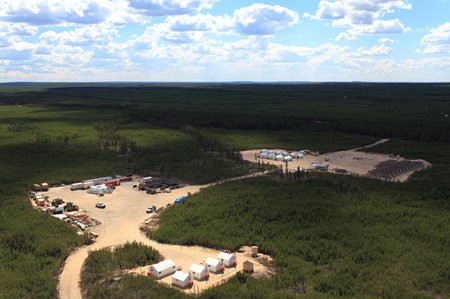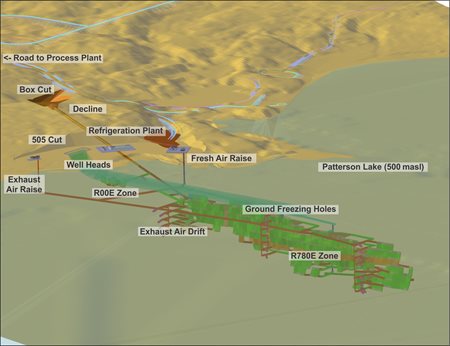
(Image via Fission Uranium. Click image to enlarge)

Investors familiar with uranium know that the market is
ripe for new projects. New nuclear plants set to open across Asia, including the recommissioning of many plants in Japan plus extensions to scheduled shutdowns of existing reactors, have created renewed interest in the commodity.
Additionally, it has inelastic demand from existing operators, and because of past market conditions, uranium is entering a tipping point of constrained supply. According to the World Nuclear Association’s
September 2019 report on nuclear fuel, uranium projections are up in all scenarios, including 49% base case growth. With secondary inventory being consumed and a growing demand gap, the report calls for restarting idle mines and new sources of uranium.
What investors might not know is that the best plays for uranium are right here in Canada. The country is the
second highest producer of Uranium , with North Saskatchewan’s Athabasca Basin being home to some of the largest sources of uranium in the world. Storied success in the region means mining initiatives in the area receive strong local support.
That’s what makes the latest news from
Fission Uranium (TSX:FCU, OTC:FCUUF, Forum) an eye-opener. The development-stage company’s Patterson Lake South (PLS) property has a large, near surface and high-grade resource estimate for uranium and now has further developed a scenario to access this resource via an underground-only prefeasibility study.
Earlier in April 2019, the Company examined the potentiality of the Triple R Deposit via a prefeasibility study with mine development as a hybrid open-pit and underground mine. This option showed viability and strong positive economics. But the study also left the door open for another potentially profitable development option by providing a Preliminary Assessment study-level look at development of an underground-only option.
Fission initiated the effort set to examine the second plan further at a Prefeasibility study level, and on Sept. 23, 2019, the results of this study were announced. The study of an underground-only mine showed a substantial reduction in capital expenditures and time requirements over the hybrid model. In addition to reducing the construction timeline by a whole year to 3 years total and a 21% reduction in capital costs to $1.18 billion,
the positive economics of theproject increased to a pre-tax IRR of 34%.
Ross McElroy, President, COO and Chief Geologist of Fission, commented that the study results mean the Company is ready to take its Triple R deposit to the next stage.
"…The report highlights important potential advantages to the underground approach, including large reductions in capital expenditure, construction time and surface footprint, while still enjoying low operating costs and a very strong return on investment. We are delighted by the results and have demonstrated the flexibility of the Triple R to be mined by multiple methods. Fission is now able to transition confidently into the feasibility study phase."
A major takeaway from the prefeasibility study is that Fission Uranium’s resource is the real deal. The updated resource estimate from the underground mine is of 2,299 kilotons at a grade of 1.61% U
3O
8 for a total of
81.4 million pounds U3O8 and used the following parameters:
- CIM definitions (2014) were followed for Mineral Reserves.
- Underground Mineral Reserves are reported using stope shapes generated with a 0.25% U3O8 minimum grade.
- This cut-off grade is based on a price of US$50 per lb U3O8 and an exchange rate of US$0.75/C$1.00.
- For underground mining, a minimum mining width of 3.0 m was used, which includes 0.5 m dilution on both the hanging wall and footwall.
- An extraction factor of 95% was applied.
The study gives an underground-only mine a seven-year production life with a pre-tax NPV at 8% of $1.33 billion that pays back in 2.2 years.
The underground mining scenario also adds many significant advantages to the project over the hybrid model. For starters, it strongly protects the groundwater by utilizing artificial ground freezing. Further, by eliminating the need for a system of dykes, slurry walls, dewatering, and overburden removal, the underground method results in a reduction of 90% of total mine-related earth movement and 58% reduction to the total disturbed area.
 (Image via Fission Uranium. Click image to enlarge)
(Image via Fission Uranium. Click image to enlarge)
Again, this is all in a region that is already familiar with uranium mining. The prefeasibility study evaluation of the processing plant and infrastructure is similar to that of current and past operations in the Athabasca region.
For many, the most important parts of any potential mine are the economics, and Fission’s PLS looks to deliver for the local communities and first nations peoples as well as for both the provincial and federal governments and for the Company. After deducting the Saskatchewan Government’s revenue royalties of $381 million,
the study estimated net revenue from the mine at $4.869 billion.
And investors should note that the prefeasibility study only assesses two zones of the Triple R deposit; the R780E and R00E zones. Further significant resources may come from future inclusion of depth extensions of the R780E zone at depth and the possible inclusion of R1515W, R840W and R1620E zones assuming successful conversion of inferred categorized resource to indicated classification, as a result of more drilling. Fission Uranium’s PLS Property comprises 17 mineral claims totalling 31,039 hectares in the Athabasca Basin, with the Triple R Deposit highlighted for being the most significant high-grade near-surface project in the region.
In order to capitalize on the Company’s further findings, the underground plan was designed to accommodate additional resources from three zones with Inferred Resources which were added later to the Triple R Deposit. In the past, Fission was able to successfully convert Inferred classified resources at R780E and R00E to Indicated classification, and if it’s able to do the same on the other zones, the economics may improve and the mine life may increase.
Once the Triple R Deposit is fully realized, the PLS Property still has a lot more room to grow. The vast majority of the property is underexplored, and contained within are more than 100 basement hosted electromagnetic conductors on large structural trends in the area that make for perfect exploration hotspots. The Triple R Deposit, open in multiple directions and at depth, is associated with just one of the conductors.
For now, Fission Uranium has two strong prefeasibility studies in hand and is set to continue moving forward. It has shown that its uranium resource is attainable, profitable, and responsible. Now that the world has started to look at uranium once again, Fission looks to be in position to capitalize at the perfect opportunity.
FULL DISCLOSURE: This is a paid article produced by Stockhouse Publishing.